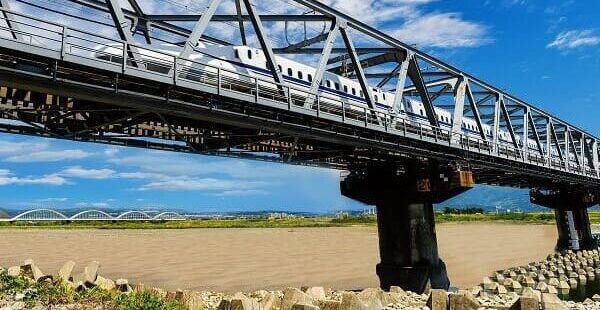India’s first bullet train is more than a transport revolution — it is a story of steel innovation driving the nation’s future infrastructure. The Mumbai–Ahmedabad High-Speed Rail (MAHSR) corridor, stretching 508 kilometres across Maharashtra and Gujarat, is redefining how India travels. Behind its promise of a 320 km/h journey lies an equally compelling tale — one of design precision, structural ingenuity, and the extensive use of steel.
The Story Behind the Span
In early 2025, a defining milestone was achieved near Kim–Sayan in Gujarat when engineers from the National High-Speed Rail Corporation Limited (NHSRCL) successfully launched a 100-metre-long steel bridge over four active railway tracks.
Fabricated in Bhuj and weighing 1,432 metric tonnes, this ‘Make in India’ structure was positioned over both Western Railway and Dedicated Freight Corridor (DFC) lines — all while keeping them operational.
Executing such a complex launch over live tracks required surgical precision. The operation was completed overnight using strand jacks and synchronised Hillman rollers, allowing traffic to continue unhindered.
This bridge is one of 28 planned steel structures on the corridor (17 in Gujarat and 11 in Maharashtra) — a clear reflection of India’s growing capability in large-span steel engineering.
Why Steel Prevails in High-Speed Rail
For a system designed to operate at speeds exceeding 320 km/h, every structural component — from girders to bearings — must withstand dynamic loads, aerodynamic pressure, and vibration, while maintaining stability and comfort.
Traditional concrete girders, although cost-effective, are limited in span and flexibility. Steel, on the other hand, offers a superior strength-to-weight ratio, allowing longer spans — in some cases up to 100 metres — with exceptional precision and resilience.
Each bridge in the MAHSR project incorporates:
- High-tensile structural steel plates offering superior yield strength
- Over 60,000 high-strength Tor-shear bolts for precision assembly
- C5-grade anti-corrosion coatings designed for a lifespan exceeding 120 years
- Elastomeric bearings to absorb vibration and reduce noise
- Continuously welded decks to ensure smooth train passage
This combination of advanced materials and design ensures structural integrity while delivering a quiet, stable, and comfortable ride.
Design and Structural Intelligence
The bullet train bridges employ a continuous open-web truss design, enhancing aerodynamic performance and reducing resonance. Each module is prefabricated using robotic welding and laser-guided alignment to achieve millimetre-level precision before being transported from Bhuj to site via multi-axle hydraulic trailers.
At the construction site, engineers employ strand-jack technology to lift and position the bridge over existing tracks — a method derived from Japan’s Shinkansen practices. This enables accurate, rapid installation without disrupting India’s busiest rail corridors.
Every span embodies a modern design philosophy — merging safety, efficiency, and aesthetic engineering into a seamless structure that symbolises the nation’s infrastructural advancement.
Passenger Experience: Comfort in Motion
While engineering feats dominate the headlines, the ultimate test lies in passenger experience. The aerodynamic bridge profiles and steel deck designs reduce vibration and noise, ensuring a smooth, gliding journey even at 320 km/h.
Precision in track alignment across the steel spans guarantees consistent geometry, translating into minimal lateral movement and an exceptionally stable ride — comparable to aircraft comfort levels.
Furthermore, the durability and low maintenance of steel bridges promise fewer service disruptions and enhanced operational reliability.
As each station seamlessly integrates with its urban context, the bullet train is set to offer not just speed, but comfort, connectivity, and a distinctly modern travel experience.
Sustainability in Steel
Beyond strength and performance, steel contributes significantly to sustainability. The MAHSR’s bridges are entirely fabricated in India, reducing carbon emissions associated with imports and long-distance logistics.
Steel’s recyclability and extended lifespan make it the ideal material for sustainable infrastructure. NHSRCL estimates that the use of high-grade steel bridges will reduce maintenance costs by around 30% over their operational life.
Equally important, the fabrication process has helped nurture domestic manufacturing skills and elevate India’s standing in advanced steel engineering.
Setting the Pace for India’s Steel Future
The MAHSR project marks a paradigm shift — from conventional, concrete-dominant construction to hybrid, steel-intensive infrastructure.
For India’s steel sector, this represents immense potential: demand for fabricated steel sections, precision fasteners, and specialised coatings is set to surge, opening avenues for innovation and value addition.
Each bridge stands as tangible proof that India’s engineering and fabrication capabilities are ready to compete with global standards. From design studios in Delhi to fabrication yards in Bhuj, the project embodies a national drive towards world-class infrastructure.
The Tracks Ahead
As India’s first bullet train nears reality, its steel bridges quietly narrate a story of strength, sustainability, and national ambition. Each span launched is not merely a structure — it’s a statement of intent, reflecting India’s progress and precision.
The Mumbai–Ahmedabad High-Speed Rail corridor is more than a transport link; it is a symbol of how steel binds innovation with mobility. From engineers who conceived it to passengers who will soon experience it, this project captures the energy of a nation in motion.
Stay tuned for our next “Infrastructure Deep Dive”, where we explore how advanced steel design is reshaping India’s bridges, airports, and metro systems — one span at a time.




